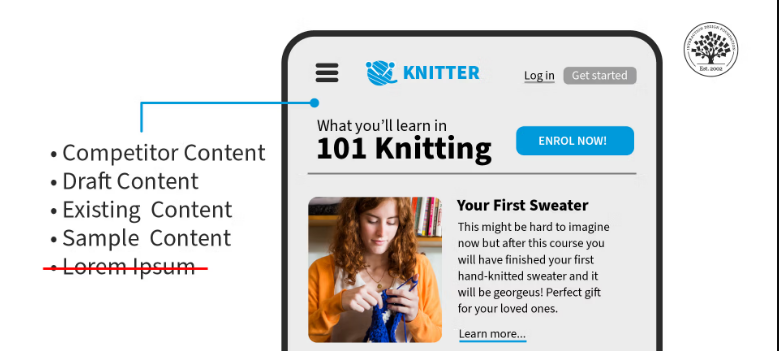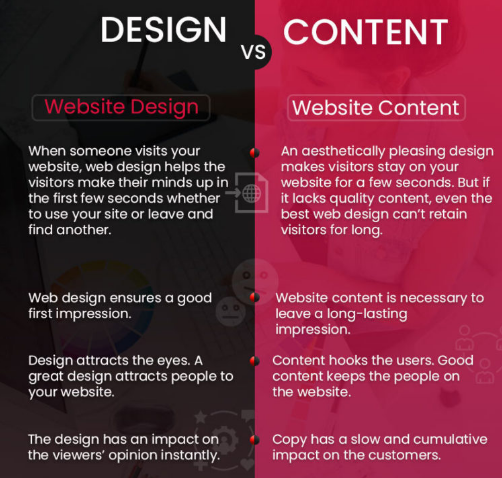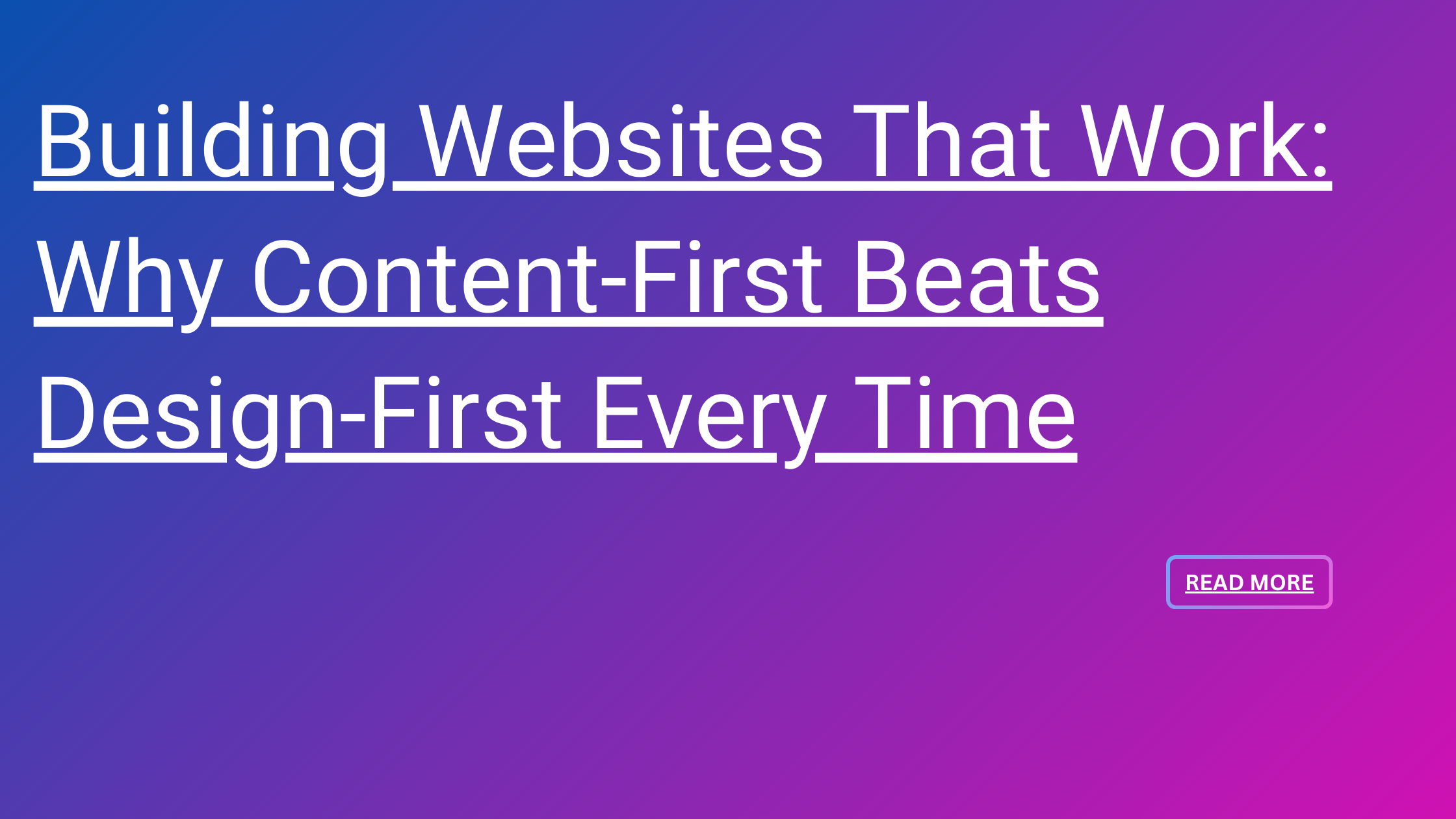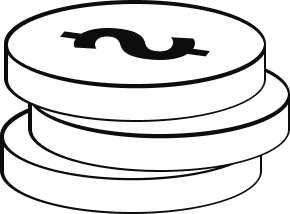Consider the last film or program you saw. If the costume designer needed to select clothing prior to the script being written, that would be unusual, right? They would have no idea what the characters are like, what era it is, or where the action is set. The same applies to set designers, camera operators, and editors. It would be chaos.
That’s pretty much what you get when you create a website without content. You can certainly create a pretty design with dummy text like “Lorem Ipsum” and dummy images, but when the actual content comes along, things do not quite fit. The message may not fit with the layout, or the words may not fit into the space you allocated.
Let’s discuss the reasons why building with content first is a better approach to creating websites and apps.
What Does “Content-First” Mean?
Content-first means you create the content before designing anything. Content includes:
- Text
- Photos
- Videos
- Forms
- Buttons
- Charts
- Tables
- Social media posts
Basically, it is everything users will read, see, or interact with. If you removed all the design, good content should still tell the user what the product is about and what to do next.
Without content, a design is just an empty shell.
Why Do People Design First Instead of Starting with Content?
There are a few common reasons:
- “We have always done it this way.”
- “Waiting for content takes too long.”
- “It is easier to show the design first and fill in the text later.”
But if you think back to the problems you have faced—missed deadlines, unhappy clients, endless changes—those issues often happen because of designing without content.
Problems with Designing Before You Have Content
1. Too Much Content
Let us say you design a perfect layout. Then the content team sends over huge blocks of text. Now you have to either:
- Squish all the words into a small space (which looks bad),
- Ask the writer to cut it down (which weakens the message), or
- Redesign everything (which takes time and money).
None of these options is good.
2. Too Little Content
What if the writer sends only a few short lines? Now your beautiful design has lots of empty space. You can not just stretch the text. You could remove some design parts, but then things may look strange or incomplete. Again, you might have to redesign.
3. Content You Did not Expect
Sometimes, a writer might add something like a table or a chart that they did not plan for. Now you need to go back, design that table, update your style guide, and make sure everything still matches. This can lead to more work and more delays.
The Good Things About Content-First Design
When you create content before designing, everything fits together better. It is like writing a script before making a movie. The visuals support the story, not the other way around.
Here are a few more benefits:
- Better for SEO: Search engines like Google understand and rank your site better when the content is written first and fits well.
- Better for mobile: Writers can plan the content to fit smaller screens, which makes it easier to design for mobile-first.
- Less rework: When content comes first, you won’t need to redesign as much.
One Thing to Keep in Mind
Content-first does not mean the writer works alone. The designer and the writer must work together. Also, the writer should understand basic design ideas like:
- Keeping things simple
- Using clear headings
- Knowing how web pages are built
If the writer and designer do not communicate well, content-first won’t work either.
How to Do Content-First Design (Step by Step)
Step 1: Research
Start by learning about the users and looking at what competitors are doing. But this time, do not just look at the design. Look at the content:
- What pages do they have?
- What is each page about?
- What visuals do they use?
If the brand already has a website, the writer should check what is working and what’s not. That way, you can plan what needs to be improved.
Step 2: Plan and Create a Site Map
Next, work with the writer to answer:
- What is the goal of this site or app?
- What message are we trying to share?
- What actions do we want users to take?
Then, make a list of pages and what each one will do. This list is your site map. It helps you see the structure and plan how users will move through the site.
Step 3: Make Content Briefs
Now, the writer creates content briefs for each page. These briefs are like mini-plans and include things like:
- Page title
- Target audience
- Main idea
- Word count
- Headings
- Internal links
- Notes about images or special content
These briefs help the team stay on the same page. You can also show them to the client early to make sure you are heading in the right direction.
Step 4: Create Wireframes and Templates
Now it is the designer’s turn. Using the content briefs, create wireframes (basic layouts of each page). The briefs tell you:
- What sections to include
- Where to put headlines
- How long should the page be
- What extra parts are needed (like forms or charts)
If there are lots of similar pages, like product pages or blog posts, you can build templates to keep things neat and consistent.
Once wireframes are done, check them with the writer to make sure everything works well.
Step 5: Write the Content
Now the writer creates the actual content. Since they already have a plan and know what the design looks like, this part goes smoothly.
Writers may also help find or suggest images, videos, or other visuals to go with the text.
Once the writing is done, it should be reviewed by the designer and then by the client.
Step 6: Design, Build, and Launch
Now, you can build your final designs using the real content. This is much better than using fake text, which can cause problems.
Some people use “proto-content” (like copying from old websites or making up rough drafts), but this can lead to mistakes, like leaving in the wrong text or even copying from other websites, which is a bad idea.
It’s better to wait for the final content and design with it. After the design is done, ask the writer to do a final check to catch small errors and make sure everything works well.
Conclusion
Do not wait until the end to add content to your designs. Start with the message first. Yes, it might take a little more planning, and you might have to wait for the content. But in the end, everything will run more smoothly.
When the message is strong and clear from the start, the design will support it perfectly. That means fewer mistakes, less rework, and a better experience for your users.
A content-first approach helps you build websites and apps that are not only beautiful but also useful, clear, and easy to use.


